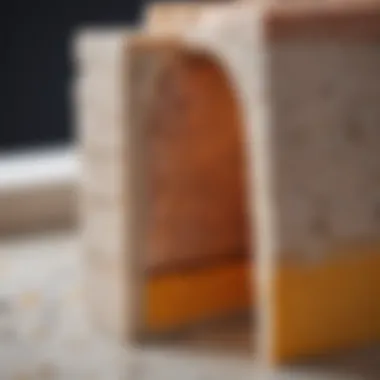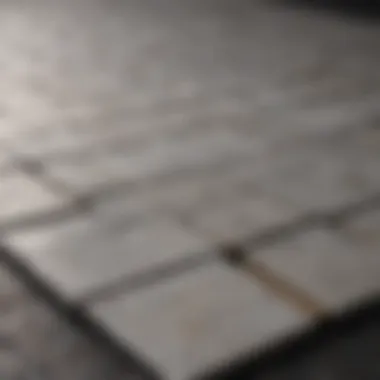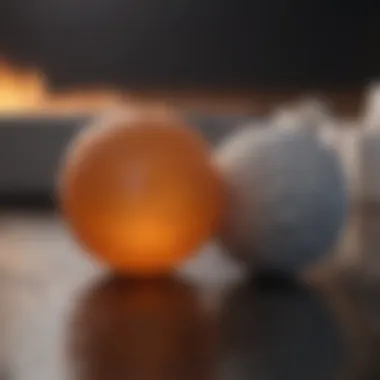Exploring the Insulating Power of Ceramic Materials


Intro
Ceramic materials have been a significant focus in both academic research and industrial applications due to their unique properties. Among these properties, insulation stands out as a critical area of inquiry. Understanding how ceramics can effectively insulate against thermal and electrical conduction is vital for advancements in various sectors, including electronics, construction, and aerospace. This article will explore the mechanisms that enable ceramics to perform as insulators, their comparative advantages over other materials, and the specific applications that benefit from these properties.
Research Overview
Methodological Approaches
Research in the field of ceramic insulation typically involves both experimental and theoretical methodologies. Laboratory experiments often focus on the thermal and electrical conductivity of different ceramic compositions. Researchers measure the performance of ceramics like alumina, zirconia, and silicon nitride in various conditions. Advanced techniques such as scanning electron microscopy (SEM) and X-ray diffraction (XRD) are commonly employed to analyze the microstructure and phase composition of ceramics, which directly affect their insulating properties.
Significance and Implications
The significance of ceramic materials in insulation cannot be overstated. Their ability to maintain temperature stability and electrical performance is crucial in industries where both extremes are risk factors. In the electronics industry, for instance, ceramics are essential for the design of capacitors and insulators that withstand voltage fluctuations. Understanding these properties enables engineers and manufacturers to design safer, more efficient products. Moreover, as global energy demands grow, the need for effective insulation in construction becomes imperative to enhance energy efficiency and reduce carbon footprints.
Current Trends in Science
Innovative Techniques and Tools
Recent trends indicate a shift towards employing nanotechnology in the enhancement of ceramic insulators. By manipulating materials at the nano scale, researchers can create ceramic composites that exhibit superior insulation characteristics. This innovation not only boosts performance but also opens doors to new applications in fields like renewable energy and nanotechnology.
Interdisciplinary Connections
The study of ceramic insulation intersects with several scientific disciplines including chemistry, materials science, and engineering. Collaboration among these fields is fostering innovative developments in ceramic processing techniques. The integration of machine learning algorithms for material selection and performance prediction is also becoming a trend, enhancing the development cycle of new insulating materials.
"Ceramics offer a unique combination of insulating properties that are crucial in advanced applications. Their continuous development reflects the growing demands of various industries."
Foreword to Ceramic Materials
Ceramic materials play a crucial role in many industries due to their unique properties. Understanding these materials is essential as they find applications in sectors ranging from electronics to aerospace. Their insulating properties, specifically, make them invaluable where heat and electricity management is critical. In this section, we will explore the very definition of ceramics and the different types available, providing a solid foundation for the discussion on insulation properties to follow.
Definition of Ceramics
Ceramics are inorganic, non-metallic materials that are typically composed of metallic and non-metallic elements. These materials are hard, brittle, and have a high melting point. They can be classified based on their microstructures, which can either be crystalline or non-crystalline. More specifically, ceramics are often formed through processes like shaping and firing at high temperatures, resulting in a solid structure that exhibits various beneficial properties. These properties include resistance to heat, corrosion, and wear, making them ideal for many applications such as insulators, cutting tools, and structural components in construction.
Types of Ceramics
There are multiple types of ceramics, each characterized by its unique properties and applications. They can be broadly categorized as:
- Traditional Ceramics: These include materials like porcelain, stoneware, and earthenware. They are often used for pottery and tableware.
- Advanced Ceramics: These materials possess superior mechanical and thermal properties and are often used in high-tech applications. Examples include silicon nitride and zirconia.
- Glass Ceramics: These are materials that combine properties of glass and traditional ceramics. They are characterized by their transparency and thermal stability.
- Bio-Ceramics: Used primarily in medical applications, these ceramics are biocompatible and are often applied in dental and surgical implants.
Understanding these types is vital for grasping the insulating properties of ceramics. Each type has its distinct characteristics that contribute to its performance as an insulator. Familiarity with these categories will facilitate a deeper insight into how ceramics function in various applications, particularly concerning their insulation capabilities.
The exploration of ceramic materials lays the foundation for a comprehensive look at their insulation properties, which will be detailed in the subsequent sections.
The Insulation Properties of Ceramics
Understanding the insulation properties of ceramic materials is crucial across multiple industrial applications. Basic principles demonstrate how ceramics provide effective barriers to heat and electricity. Investing time in this subject enriches the knowledge base, particularly for students, researchers, and professionals involved in materials science.
Basic Principles of Insulation
Insulation refers to a material's ability to resist the transfer of heat or electricity. In practical terms, this means that good insulators can keep heat in (or out) while also preventing electrical flow. The properties that define insulation effectiveness include thermal resistance, electrical resistivity, and dielectric strength.
Ceramics are known for their high melting points and low thermal conductivity, positioning them as ideal candidates for insulation. They achieve this primarily due to their atomic structure; the tightly-packed ionic or covalent bonds create barriers that hinder the movement of heat and charge carriers. This is why ceramic materials are often employed in settings that require stable performance under varying temperatures or electrical stresses.
Thermal Insulation Mechanisms in Ceramics


The mechanisms behind thermal insulation in ceramics rely on a few key factors. First, the density of the ceramic influences heat transfer. Low-density ceramics, like aerogels, effectively trap air and reduce heat conduction. This principle is particularly valued in construction or aerospace applications where thermal resistance is critical.
Second, the microstructure of the ceramic plays a part. The presence of pores or imperfections can enhance insulating properties by creating additional barriers to heat flow. In fact, some ceramic materials undergo specific processing techniques to optimize their thermal insulation capacity.
As a result, applications like thermal barriers in high-temperature processes or even cookware greatly benefit from these unique thermal properties. Observing these mechanisms offers insight into why ceramics are chosen over other materials for temperature regulation.
Electrical Insulation Mechanisms in Ceramics
Ceramic materials also excel in electrical insulation, functioning through distinct mechanisms. The primary contributing factor is their high dielectric strength, which is an indicator of how much electric field a material can withstand before it becomes conductive. This feature is remarkably useful in the electronics industry.
To maintain their insulating nature, ceramics must have low electrical conductivity and resistive losses. Chemical composition, impurities, and microstructure play significant roles here. For example, materials like alumina and zirconia are frequently utilized in insulators for high-voltage power systems due to their excellent electrical properties.
In summary, the electrical insulation mechanisms found in ceramics are critical for ensuring safety and performance in electronic devices. Understanding these features allows engineers to choose the right materials for specific applications.
Advantages of Ceramic Insulators
The advantages of ceramic insulators are significant in various applications, particularly in high-stress environments. The properties of ceramics lend themselves to both thermal and electrical insulation, making them a prime material in industries ranging from electronics to aerospace. Understanding these advantages is crucial for professionals when selecting materials for specific applications. The main points of focus include high temperature resistance, corrosion resistance, and mechanical strength.
High Temperature Resistance
Ceramics are well-known for their high temperature resistance. They can withstand extreme heat without losing structural integrity. This makes them ideal for applications that involve intense thermal conditions. For example, many aerospace components rely on ceramic insulators to protect vital systems from heat generated during flight.
The ability of ceramics to sustain their properties at high temperatures stems from their robust atomic structure and strong bonding forces. Unlike many materials that may deform or degrade when exposed to elevated temperatures, ceramics remain stable. This characteristic is crucial in sectors where safety and reliability are essential. Industries must consider these factors when designing thermal barriers, ensuring that ceramics provide the desired level of safety and performance under challenging conditions.
Corrosion Resistance
Another advantageous property of ceramics is their excellent corrosion resistance. They can endure exposure to many hazardous chemicals without degrading. This makes ceramics a preferred choice in industries such as chemical processing and waste management, where materials often face corrosive substances.
The inert nature and stability of ceramic materials allow them to resist oxidation, which is a common failure mode in metals.
Key Points:
- Chemical inertness: Ceramics do not react with acids or bases.
- Longevity: Their ability to maintain performance over time reduces the need for frequent replacements.
- Reduced maintenance costs: The durability of ceramics leads to lower operational costs in industrial applications.
"Ceramic materials can endure extreme conditions that would typically lead to the deterioration of other materials, illustrating their durability and versatility."
Mechanical Strength
Ceramics exhibit impressive mechanical strength. They can handle large amounts of stress without deforming. This property becomes essential in structural applications, such as insulators in power transmission systems. Electrical insulators made from ceramics ensure the stability of operations in high-voltage environments. Their ability to withstand significant mechanical stresses is a critical factor that sets them apart from competing materials like plastics or rubber.
However, it’s important to note that while they possess high compressive strength, ceramics can be brittle under tension. This factor necessitates careful consideration during the design process, ensuring that they can be applied effectively and safely.
The combination of these three advantages—high temperature resistance, corrosion resistance, and mechanical strength—positions ceramics as superior insulators in many fields. By leveraging these properties, industries can enhance the safety and efficiency of their operations.
Limitations of Ceramic Insulators
In exploring their insulating properties, it is essential to discuss the limitations of ceramic insulators. While ceramics have distinct advantages, understanding their shortcomings provides insight into their overall performance. The focus here is on factors that affect reliability and practicality in various applications.
Brittleness and Fracture Risk
Ceramics are known for their brittleness. This characteristic means they can fracture easily when subjected to mechanical stress or impact. Unlike metals or certain polymers which may bend or deform, ceramics lack the ability to absorb shock effectively. Cracks can develop from even small stresses, which can compromise their insulation capabilities.
This brittleness poses challenges in real-world applications. For instance, in electrical insulators, a fracture can not only lead to loss of insulation but can also cause short circuits. The risk of fracture is a significant concern in industries involving high voltages or mechanical loads.
Some key points to consider regarding brittleness include:


- Temperature Sensitivity: High temperature can alter the mechanical properties, increasing brittleness even more.
- Thermal Cycling: Repeated heating and cooling can induce thermal stress, leading to cracks.
- Manufacturing Defects: Microscopic flaws during production may significantly reduce strength.
"Understanding the limits of material properties such as brittleness is crucial for safe application in engineering and other sectors."
Cost Factors in Production
Production costs for ceramic insulators can be another limiting factor. While they offer many benefits, such as temperature and corrosion resistance, the costs associated with manufacturing can be substantial. This impact on pricing often influences their adoption in various applications.
The following aspects contribute to the cost of ceramic insulators:
- Raw Material Sourcing: High-quality raw materials are required to maintain desired properties. This sourcing can be expensive.
- Complex Manufacturing Processes: The processes to form and sinter ceramics are intricate and require controlled environments.
- Energy Consumption: The production of ceramics often demands high energy input for firing, which raises costs further.
- Labor Costs: Skilled labor may be needed to handle the intricacies of ceramic production, thereby increasing costs.
These factors influence decision-making in industries. Businesses weigh the advantages of using ceramics against the financial implications. Sometimes, opting for alternative materials that may provide lower performance at a reduced cost becomes appealing.
Comparative Analysis: Ceramics vs. Other Insulators
Understanding the insulating properties of ceramics in comparison to other materials is vital in various industries. This section dives into comparative analysis to highlight the unique advantages ceramics present. By evaluating ceramics against plastics and metals, we can gain insights into their performance, durability, and adaptability in different contexts.
The choice of insulation material can significantly influence the efficiency, safety, and longevity of an application. Hence, this comparative analysis serves to inform material selection, ensuring optimal performance.
Ceramics vs. Plastics
When comparing ceramics and plastics, several key factors come into play.
- Thermal Resistance: Ceramics generally excel in high-temperature environments. They can withstand temperatures exceeding those safe for most plastics, which can melt or warp.
- Electrical Insulation: Both ceramics and plastics serve as effective electrical insulators. However, ceramics provide superior performance when high dielectric strength is required. This is crucial in applications such as high voltage conditions, where even a slight breakdown can lead to failures.
- Durability: Ceramics are less susceptible to wear and tear compared to plastics. Their rigidity and mechanical strength lend to a longer life span in abrasive environments. For instance, ceramic insulators are often used in harsh conditions like power lines, outperforming plastics in longevity.
On the flip side, plastics can be lighter and often cheaper to produce, making them attractive for specific uses. They can also be molded into complex shapes more easily than ceramics.
In summary, ceramics offer significant advantages in durability and high-temperature applications, while plastics may serve better in low-cost and lightweight solutions.
Ceramics vs. Metals
The contrast between ceramics and metals reveals an important examination in the field of insulation.
- Thermal Conductivity: Metals are typically good thermal conductors, which can be an advantage in some applications, but when insulation is the priority, ceramics outperform metals in terms of thermal resistance. High-performance ceramic insulators can effectively prevent heat transfer, thus maintaining system integrity.
- Electrical Insulation: While most metals conduct electricity, ceramics are non-conductive. This feature makes ceramics ideal for applications requiring electrical insulation. For instance, in electronic circuits, ceramics are crucial to prevent shorts and other electrical failures.
- Corrosion Resistance: Ceramics stand out in harsh environments where corrosion is a concern. Metals are often susceptible to rust and degradation over time, especially in moisture or chemical-laden environments. Ceramics, due to their chemical inertness, resist corrosion effectively, allowing for longer operational suitability.
Nevertheless, metals generally provide better mechanical toughness, exhibiting less brittleness under sudden impacts or forces. This makes ceramics potentially more vulnerable to fractures under high strain.
Applications of Ceramic Insulators
Ceramic insulators play a significant role in various industries due to their unique properties. These materials are essential for effective insulation, providing critical benefits in electrical and thermal environments. Understanding these applications helps elucidate their importance and effectiveness in practical settings.
High Voltage Electrical Applications
In high voltage electrical systems, ceramic insulators are widely used to prevent electrical conduction and ensure safety. Their high electrical resistivity makes them ideal for isolating conductive elements. Applications include:
- Transmission Lines: Ceramic insulators are often used in power transmission lines, enabling long distances to be covered without energy loss.
- Substations: They are used to support electrical lines and components, providing robust insulation under high voltage conditions.
- Circuit Breakers: Here, ceramics safely isolate electrical components during high-load conditions, maintaining system integrity.
The use of ceramic materials in these applications not only enhances performance but also prolongs the lifespan of electrical infrastructure. Studies show that the durability and performance of ceramics in extreme conditions significantly reduce maintenance costs.
Thermal Barriers in Aerospace
In aerospace engineering, ceramic insulators serve as thermal barriers, which are crucial for protecting sensitive components from extreme temperature variations. Ceramics can withstand high temperatures and can effectively insulate against heat transfer. Key aspects include:
- Thermal Protection Systems (TPS): Ceramic materials are integral to TPS designed for spacecraft. They help manage the intense heat generated during re-entry into the atmosphere.
- Engine Components: Used in turbine engines, ceramics prevent heat from damaging vital engine parts, contributing to overall efficiency.
- Lightweight Solutions: The low density of ceramic materials makes them suitable for applications where weight reduction is critical, such as in aircraft design.


Overall, the ability of ceramic insulators to withstand harsh conditions improves safety and performance in aerospace applications, making them invaluable.
Pottery and Tableware
Beyond industrial applications, ceramics have a longstanding place in daily life, particularly in pottery and tableware. Here, their insulating properties translate to functional benefits, such as:
- Heat Retention: Ceramic dishes maintain food temperature longer, enhancing the dining experience.
- Thermal Shock Resistance: Good ceramics can withstand sudden temperature changes, making them suitable for oven and microwave use.
- Aesthetic Appeal: Modern ceramic designs combine functionality with art, reflecting a blend of utility and beauty.
Ceramics in tableware not only serve practical purposes but also satisfy consumer demand for durability and style. This aspect contributes to their ongoing popularity in households worldwide.
"The integration of ceramic insulators in various applications showcases their versatility and performance, emphasizing the importance of research and innovation in material science."
In summary, ceramic insulators span various sectors, from electrical engineering to daily domestic use. Understanding their applications provides insights into their benefits and the technological advancements that continue to evolve ceramic materials.
Future Trends in Ceramic Insulation Research
Future trends in ceramic insulation research represent a critical facet of advancing technology and material sciences. As industries evolve, the demand for more efficient, durable, and innovative insulating materials intensifies. Ceramic materials have long been recognized for their insulating properties, but ongoing research is revealing new potentials that can extend their applications. This section will explore the most promising areas in ceramic insulation, including nanostructured ceramics and smart ceramic materials. Understanding these trends is essential not just for researchers, but also for industries looking to leverage new technologies for competitive advantage.
Nanostructured Ceramics
Nanostructured ceramics have emerged as a major focus in material science due to their enhanced properties compared to traditional ceramics. By manipulating the microstructure at the nanoscale, researchers can create ceramics with superior strength, lighter weight, and improved thermal and electrical insulating properties.
Some of the benefits of nanostructured ceramics include:
- Enhanced thermal stability: Smaller grain sizes help in dispersing heat more effectively, leading to better thermal resistance.
- Improved electrical insulation: Reductions in defects at the nanoscale can lead to lower electrical conductivity, enhancing insulating properties.
- Applications in advanced industries: These materials are useful in aerospace, electronics, and energy sectors where high performance is crucial.
For example, research on nanoparticles made from materials like silicon nitride or alumina shows promise for creating composites that can stand high temperatures and severe environments while retaining low thermal conductivity. This enhances their appeal for insulation in high-performance industries.
Smart Ceramic Materials
Smart ceramic materials represent another noteworthy trend, integrating intelligence into the ceramic itself. It allows ceramics to respond dynamically to changes in their environment. This can include altering their insulating properties based on temperature changes or even electrical stimuli. Such adaptability opens up new avenues for practical applications.
Key features of smart ceramic materials include:
- Responsive insulation: The capability to change properties in real-time can lead to energy-efficient systems in something as simple as heating elements.
- Integration with sensors: These materials can be embedded with sensors to monitor changes, thus providing data that can enhance operational efficiency across different environments.
- Multifunctionality: Beyond insulation, smart ceramics can offer other functionalities, like self-healing or increased durability against physical wear and tear.
The development of smart ceramics is still in early stages, but prototypes have already demonstrated functionality in various research projects, including buildings that maintain optimal temperatures through advanced insulation techniques.
The future of ceramic insulation research is promising, aiming to create materials that are not only effective but also intelligent and responsive, driving efficiency in many industrial applications.
"Innovative advancements in ceramic materials could redefine insulation standards across multiple industries, enhancing energy efficiencies and performance outcomes."
Advancements in nanostructured and smart ceramic materials thus play a vital role in the evolution of insulation technology, enabling a new era of energy-efficient solutions.
Finale
The final section of this article underscores the critical role ceramic materials play in insulation technologies. Understanding the insulating properties of ceramics is not merely an academic pursuit; it has real-world implications across various industries. As we deliberate on the complexities of ceramic insulators, it is vital to recognize their unique characteristics that drive both their advantages and limitations.
Summary of Insulation Benefits
Ceramic materials offer several benefits in insulation applications. These include:
- High thermal stability: Ceramics can withstand extreme temperatures without degrading, making them ideal for high-temperature environments like aerospace and automotive sectors.
- Excellent electrical insulation: Many ceramic materials, such as alumina and porcelain, are effective at preventing electrical conductivity, which is critical in high-voltage applications.
- Corrosion and wear resistance: Ceramics can endure harsh chemicals and abrasive conditions, ensuring long-lasting performance, particularly in industrial contexts.
- Low thermal conductivity: Certain ceramics can significantly reduce heat transfer, providing efficiency in thermal insulation applications.
These benefits position ceramics as a preferred choice for various insulation needs, influencing their implementation in technologies and products worldwide.
Final Thoughts on Ceramic Insulation
As we reflect on the role of ceramics in insulation, it is important to acknowledge the ongoing research and advancements in this field. Innovations in nanostructuring and smart materials are paving the way for enhanced performance and new applications.
"The future of ceramic insulation lies in adapting their properties to meet the growing challenges in technology and environmental considerations."



